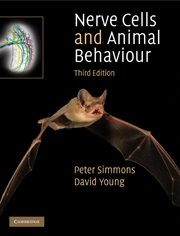Book contents
- Frontmatter
- Contents
- Preface
- 1 Organisation of animal behaviour and of brains: feeding in star-nosed moles and courtship in fruit flies
- 2 Signals in nerve cells: reflexes in mammals and insects
- 3 Neuronal mechanisms for releasing behaviour: predator and prey – toad and cockroach
- 4 Neuronal pathways for behaviour: startle behaviours and giant neurons in crayfish and fish
- 5 Eyes and vision: sensory filtering and course control in insects
- 6 Sensory maps: hunting by owls and bats
- 7 Programmes for movement: how nervous systems generate and control rhythmic movements
- 8 Changes in nerve cells and behaviour: learning in bees and rats; swarming in locusts
- 9 Nerve cells and animal signalling: songs of crickets, electric fish and birds
- References
- Index
- References
8 - Changes in nerve cells and behaviour: learning in bees and rats; swarming in locusts
Published online by Cambridge University Press: 05 August 2012
- Frontmatter
- Contents
- Preface
- 1 Organisation of animal behaviour and of brains: feeding in star-nosed moles and courtship in fruit flies
- 2 Signals in nerve cells: reflexes in mammals and insects
- 3 Neuronal mechanisms for releasing behaviour: predator and prey – toad and cockroach
- 4 Neuronal pathways for behaviour: startle behaviours and giant neurons in crayfish and fish
- 5 Eyes and vision: sensory filtering and course control in insects
- 6 Sensory maps: hunting by owls and bats
- 7 Programmes for movement: how nervous systems generate and control rhythmic movements
- 8 Changes in nerve cells and behaviour: learning in bees and rats; swarming in locusts
- 9 Nerve cells and animal signalling: songs of crickets, electric fish and birds
- References
- Index
- References
Summary
One of the most important and intriguing aspects of animal behaviour is that it continually changes. As they move around actively exploring their surroundings, animals rarely behave in completely predictable ways. That is evident just by observing flies walking on a table top: they rarely take more than a few steps in one direction, but often turn and stop for short times as they walk. Animals are programmed to change their behaviour when their environment alters, which is an efficient strategy that enables them to react appropriately to a wide variety of possible situations. Some of the changes are elements of the processes of development and maturation while others allow an animal to learn about alterations in its environment so it can make and modify predictions based on experience, for example to predict that a particular action will be followed by a rewarding or an aversive event. Sometimes learning particular features only happens during restricted time periods of an animal's life history, or critical periods. These are part of a programme of the normal development of behaviour – for example an owl develops its auditory map most easily during the first few weeks after hatching (Chapter 6), and a young song bird needs to hear the songs of adults during the first few weeks of its life so that when it matures it sings a song that is effective in attracting a mate (Chapter 9).
- Type
- Chapter
- Information
- Nerve Cells and Animal Behaviour , pp. 193 - 221Publisher: Cambridge University PressPrint publication year: 2010



